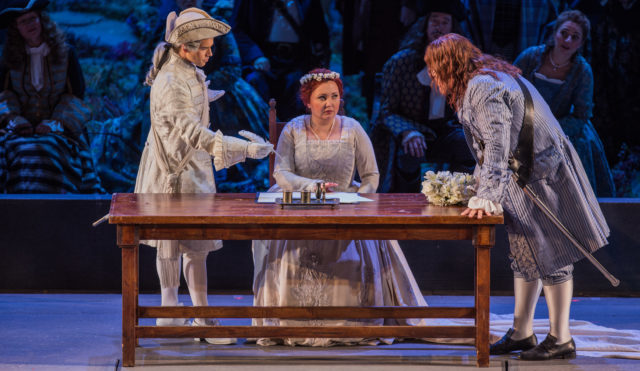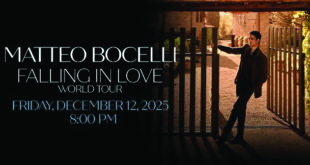
It has been said about theatrical reviewing that if the reporter writes about the directing, sets and whatnot, then the dramatic performances were probably not all that great. But I will say that the Chicago Lyric Opera 2016-17 staging of Donizetti’s “Lucia di Lammermoor” is one of the very best directed and designed productions I have ever seen. At the same time, however, the performance on Tuesday evening, Nov. 1, was sung magnificently, thanks in great part to the Lyric’s wonderful Lucia, soprano Albina Shagimuratova. Solid conducting, choral and instrumental work all combined to make this performance most memorable.
I usually have a very thin skin when it comes to opera stage directors, especially when their yearning to be hailed as “creative” takes them far afield from the composer or librettist’s original concepts. But, like the great Franco Zefirelli, director Graham Vick was quite faithful to the text and was still very creative. The movements of the characters was always smooth and logical, but what I really was impressed with was how he had some of them lit occasionally. (I’m positive that this had to be a director’s decision!) By this I mean that the characters would be lighted up from below rather than from above. (A very common device in expressionist films.) By doing this, Mr. Vick would have tall, spooky shadows thrown back against dark gray flats — a very remarkable effect.
The only problem I have with Mr. Vick is that for some reason, the Wolf’s Crag scene between Enrico and Edgardo is presented out of sync with the original text. There is some dramatic meaning to Enrico deceiving Edgardo about Lucy enjoying herself with Bucklaw, when he knows that his sister has killed him. (After all, Enrico has been deceiving Lucy and Edgardo for the whole opera!) Yet one wonders why this was necessary. (In the original Cammarano text, the Wolf’s Crag scene takes place before the “Mad Scene.”)
As for those flats, these are mainly what made up the simple, but extremely clever sets. This system of flats would move vertically or laterally, or sometimes both, opening like the aperture of a camera. It was in this way that the famous “Mad Scene” unfolded, in a manner in which I have never seen it done, but one that I thoroughly enjoyed. Designer Paul Brown clearly understands how ingenious it is to make the simple profound. One more example of this is the stage curtain. It was just a very dark blue-plaid tartan with “Lucia di Lammermoor” written in glow-red script on the lower right-hand corner. Simple but effective.
As I have said many times, it is impossible to stage a successful Bel Canto opera without a super prima donna, and that is especially true of “Lucia di Lammermoor.” Fortunately, Lyric obtained the services of soprano Albina Shagimuratova, who not only sang the role brilliantly, but who presented a very believable Lucia, a figure for whom the audience was obviously very sympathetic. In her first big aria, “Regnava nel silenzio,” and with her singing in the duet with Edgardo, Ms Shagimuratova won the audience over easily. But it was the Act 3 “Mad Scene” that brought the crowd to its feet with a well deserved atypical Lyric audience ovation. For the prima donna had met the most severe challenge there is to wicked coloratura difficulties. I personally was thrilled by her trills — real ones! — which most sopranos, even good ones, just fob off. I was also happy to hear her interpolate the (unwritten) high D-flat at the end of the Great Sextet.
The part of Edgardo has never been a true Bel Canto, or light, lyrical tenor role and the Lyric Edgardo, Piotr Beczala, gave us a very strong performance, with ringing high notes and powerfully sustained long pitches. In his duet with the soprano, “Qui di sposa eterna,” Mr. Beczala also exploited his first appearance to win over the audience. But it was in his final full aria, “Tombe degli avi miei,” that the tenor really let it all hang out, and got a huge ovation from the audience, who were very happy to hear tenor singing like that.
After his first-act opening aria, “Cruda, funesta smania,” which baritone Quinn Kelsey sang very well indeed, most of Edgardo’s music is performed in various ensembles with other singers. But his strength of presence, vocally and dramatically, is an utter necessity because, in a way, the events that unfold in this tragedy are those that he has set and kept in motion. “Lucia” is really his story. As in the case of the other Lyric principles, Mr. Kelsey was well up to the task, and his energy never waned, as demonstrated by his brilliant contribution to the Wolf’s Crag duet with Edgardo, “Orrida è questa notte.”
I’m not sure that you can call Lyric’s Raimondo, Adrian Sâmpetrean, a weakness or not. He sang and acted well and the performance did not suffer because of him. Yet although he is billed in the program as a “Romanian bass,” he sounded a lot more like a baritone to me. I would have preferred a stronger, deeper vocal presence in the role.
One thing Donizetti is not credited for enough in my opinion is his very adventurous approach to orchestration, far more so than either Bellini or Rossini. Conductor Enrique Mazzola drew out all the Donizetti instrumental colors nicely and kept the excellent Lyric orchestra at a high energy level and in perfect sync with the singers throughout. While on the subject of instruments let me applaud the fine playing of harpist Marguerite Lynn Williams for her solo in the first-act soprano aria, and the terrific, precision flute accompaniment and obbligato of Ms Shagimuratova in the Act 3 “Mad Scene.”
I know that there are many reasons why opera fans can’t get to the opera house every time there’s a performance. But one like this would make everyone try harder — it was that good!
 Fra Noi Embrace Your Inner Italian
Fra Noi Embrace Your Inner Italian






I was a little girl when I first saw this at the Met in NYC. Just to give you an idea how long ago, Lily Pons was Lucia, Tagliavini was Edgardo and I think Pinza had the bass part – or, perhaps it was Merrill. Standing room tickets were 50 cents. In this day of mediocre singing and stupid antics required by the singers, because they must not “park and bark”, I’m thrilled to read this glowing critique. Would that I could have been there. Thank you also, for remembering that great master Zeffirelli, it pained him so when his productions were scrapped and replaced by staging and directing emulating Broadway shows.